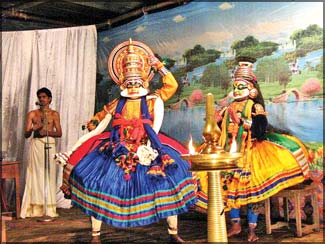Traditional and Modern dances
Subashini PATMANATHAN
Traditional dance forms in any society must have certain norms, and
defined links with cultural, linguistic, regional, and religious
factors. These traditional dance forms generally have certain long
standing historical background, and historical developments, in
different periods.
Almost all the traditional cultural dance forms are systematically
categorised into different steps, different hand gestures, eye
movements, and neck movements and different names for different foot
positions, and different foot movements.
|

A Kathakali dance performance |
Each traditional dance form has some deep meaning. Traditional
dancers vehemently stick within certain limited framework.
Even some of the traditional dance forms like Russian Ballet, western
dance forms, Eastern dance forms, South American dances, Far East Asian
dance forms, and South East Asian dance forms, are systematically
confined and defined dance techniques. Each traditional form has its own
distinguish makeup, and stage decorations, distinguish costumes, and
selective ornaments.
Most of the ornaments have certain names, as well as certain
significance for the purpose of usefulness. Some of the traditional
dance forms are only performed by solo dancers, some are only by female
dancers alone, and some are by female and by male dancers together.
At the end of the last quarter of the 20th century, a new trend of
dance form has developed by the modern choreographers.
They insert numerous ideas of their own creativity into these dances,
and also borrow techniques from numerous other traditional dance forms.
They mainly borrow the nuances, techniques, steps, costumes,
ornaments, and makeup from various, different traditional dances, and
along with these dances, they also combine their own creativity dances,
and name these as modern dances. The choreographers, borrow techniques
from Russian Ballet, gymnastics, circus, and body movement exercises. No
proper clarified, defined, categorized steps are followed in these
modern dance forms. Besides these they add jumps, hops, twists, and
sudden turns in these dances.
The choreographers adopt their own designed costumes. Most of the
choreographers adopt their own idealistic music, and select their own
musical instruments.
The musical instruments used for these dances are admixture of
Western and Eastern instruments. Even the choreographers adopt numerous
modern technologies, for the stage decorations and also for the lighting
and sound system.
The main aim of the choreographers is to attract the audience for
mere amusement, for enjoyment, for entertainment purposes. These so
called modern dances are generally performed and practised by female and
male dancers. Generally these male and female dancers participate
together in groups.
Mainly the younger generation is attracted and encouraged by these
baseless art forms. Even some of the schools in the metropolitan areas
encourage these modern dances, to attract the younger generation for
fashion shows, and extra activities in the school level. |



